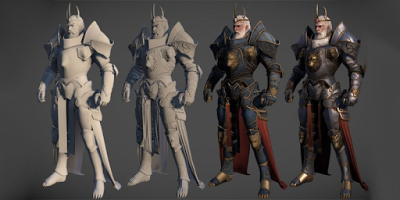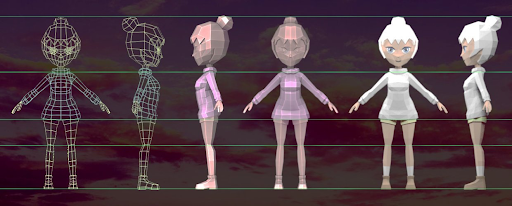Creating 3D Character Models can be a difficult task, but it becomes much easier when you have access to quality references and design guides. In this article, we will discuss the different types of references that can be used for 3D Character Modeling, as well as tips for designing characters without any reference images. We will also take a look at some of the best resources for finding high-quality 3D character models and textures.
Table of Contents
1. What is 3D Character Modeling
3D character modeling is the process of creating a three-dimensional representation of a character. This can be done through any number of means, but most commonly it is done through the use of specialized software. The resulting model can then be used in a video game or other digital environment. Character models are typically created by artists who have a strong understanding of human anatomy and proportions. However, it is also possible to create models using photos or scans of real people. The process of 3D character modeling can be quite complex, but the end result is a lifelike and detailed representation of a character that can be used in any number of ways.
There are many different types of characters that might be found in a video game. Some games focus on realistic human characters, while others feature anthropomorphic animals or fantasy creatures. The approach to 3D character modeling depends on the type of game being developed. For example, a game that focuses on realism might require detailed models of facial expressions and clothing, while a more fanciful game might require less detail. There are also different software programs that can be used for character modeling, each with its own advantages and disadvantages. Ultimately, the best approach for any given project depends on the specific requirements of the game.
2. The different types of references that can be used for 3D Character Modeling
There are a variety of different types of references that can be used for 3D character modeling.
- One common type of reference is a photograph. Photographs can be helpful in capturing the overall proportions of a character, as well as small details such as facial features.
- Another type of reference that can be used is a drawing or painting. Drawings and paintings can be useful for understanding the general shape of a character, as well as for studying specific details such as clothing folds or muscle structure.
- Finally, clay models can also be used as references for 3D character modeling. Clay models can be helpful in understanding the volume and proportions of a character, and they can also be used to create custom texture maps.
Ultimately, the best type of reference to use will depend on the specific needs of the modeler.
3. Using reference images to create a character’s model
Character modeling is a crucial step in the 3D animation process. It involves creating a digital representation of a character that can be manipulated to create realistic movements. While there are many different approaches to character modeling, one of the most effective techniques is to use reference images. By studying reference images, you can get a better understanding of the proportions and features of your character, and this information can be used to create a more accurate model.
There are several different ways to find reference images for your character. If you are working on an original design, you may want to search for images of real-world objects that share similar characteristics with your character. For example, if you are creating a character that is based on a cat, you could look for pictures of cats or other felines. You can also look for images of people or animals that have similar body types or facial features. Once you have found some reference images, it is time to begin creating your model.
Start by creating a basic wireframe of your character. This will help you to establish the overall proportions of your character and get an idea of its general shape. From there, you can begin adding details such as facial features, clothing, and accessories. As you add details, be sure to refer back to your reference images so that you can accurately recreate the proportions and features of your character. With careful planning and execution, using reference images can help you create a lifelike and believable 3D character model.
4. Designing characters without any reference images
When it comes to creating characters, many artists start by looking for reference images. However, it is also possible to design characters without any reference material. This can be a helpful exercise for developing your imagination and honing your design skills. So how do you go about creating a character without any reference images? Here are a few steps to get you started:
- Start by brainstorming the basics of your character. Think about their name, age, gender, race, and personality.
- Once you have a basic idea of who your character is, begin sketching them out. Start with the overall shape of their body and then add details like facial features, clothing, and accessories.
- As you sketch, pay attention to proportion and balance. This will help ensure that your character looks realistic and believable.
- Once you’re happy with your sketches, it’s time to start bringing your character to life with color and shading. Again, paying attention to detail is important here. Think about things like skin tone, hair color, and eye color.
- Finally, give your character a background story. What’s their history? What motivates them? What are their goals? Answering these questions will help you bring your character to life in a truly three-dimensional way.
5. Tips for creating better 3D Characters
Character modeling for games is one of the most important aspects of video games and it is all about creating believable and relatable characters. After all, players need someone to identify with as they experiment with different gameplay mechanics and progress through the game’s story. A well-designed character can make all the difference in whether a player enjoys the game or not. That’s why many developers spend a lot of time and effort on character modeling. By creating realistic models, they can ensure that players will be able to connect with the game’s characters on a personal level. In addition, a well-crafted model can also help to sell the game’s setting and further immerse players in the experience. Character modeling is therefore a critical component of game design, and one that should not be overlooked.
When creating 3D characters, there are a few things to keep in mind in order to create characters that are believable and relatable.
First, it is important to create a character that is convincingly human. This means paying attention to details like facial expressions and body language.
Secondly, the character should be designed with a specific purpose in mind. What is the character’s role in the story? How will they interact with the other characters?
Thirdly, the character’s design should be appropriate for the setting in which they will exist. A character that is too “fantastical” may not be believable in a realistic setting, for example.

Conclusion
In order to create believable and relatable 3D characters, it is important to consider a few key things. First, pay attention to details like facial expressions and body language in order to make the character seem human. Secondly, design the character with a specific purpose or role in mind. Thirdly, make sure the character’s design is appropriate for the setting in which they will appear. Following these tips should help you create 3D characters that are realistic and engaging.
















